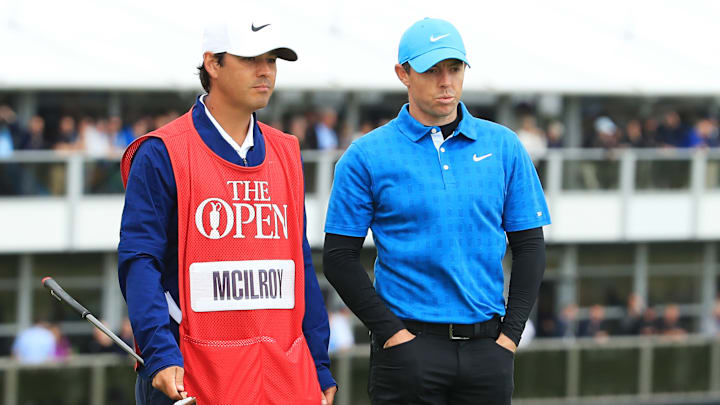The Open Championship returns to Royal Portrush after last visiting in 2019 this week. While Shane Lowry won the event with a score of 15-under, the fact of the matter is that the Northern Ireland tract still presents a mightily difficult task. There is trouble all around on the coastline course, even for the best in the world competing at the British Open. But one hole in particular could prove particularly make-or-break in the final major championship of the year at The Open: The first hole.
Make no mistake, there are many holes throughout the 18 that players will see in each round that could prove troublesome. Perhaps the most famous is the 16th hole, known as Calamity Corner at Royal Portrush. The signature hole is a blistering Par 3 that measures 236 yards and a menacing green complex. Like many holes, the elevated greens with such a long iron shot in can prove troublesome, but especially on the 16th.
The green is exposed to the winds off the coast, which makes putting hard, but there is thick rough that the green runs off to on the right side, but many shots that can miss end up some 50 feet below the green, making getting up and down a monumental task. After all, in 2019 at The Open, Calamity Corner yielded only 24 total birdies throughout all four rounds. It's a bear, but it doesn't present the exact same challenge as the first hole.
While the 16th hole could potentially play a factor in how the end of the British Open plays out, the first hole could make some players D.O.A.
The first hole at Royal Portrush could prove diabolical in the British Open
The first hole at Royal Portrush, named Hughie's, isn't all that daunting on the scorecard, a Par 4 measuring just 420 yards. However, the design of the hole is truly a test of the mind to start each round, especially with the shots that it demands from players more often than not, which starts when they're standing on the tee box.
When players are teeing off, the short-ish Par 4 isn't one that you can overpower without taking on a tremendous amount of risk. The fairway is not only a links-style with the potential for wonky bounces, but that's made even more worrisome with the fact that it's lined with in-course out-of-bounds on both sides of it. Further amplifying the task at hand, there is a daunting fairway bunker some 290 yards from the tee box. For that reason, many players elect to hit less than driver — or should — off the first tee.
The task doesn't get a ton easier from there, however, players aren't out of the woods. There's a false front on the green that players will have to avoid on their approach, but bailing to the left isn't an option either with a canyon-like bunker that can make getting up and down next to impossible for par. Throw in a green that's highly based on positioning to have an easy time putting for even par, the challenge is clear.
What stands out about the test of this hole, particularly at The Open, is that players are forced to balance the pressure of a round immediately. The first tee is lined with spectators who are thirsty for golf. It's only human nature to feel the adrenaline and want to blast driver, especially on a shorter Par 4. However, the penalty of doing so can be severe, so it forces players to take their medicine and play wisely right from the get-go, and then to have the fortitude beyond the tee shot to keep doing the same.
Don't forget Rory McIlroy and J.B. Holmes' tournaments going awry at the first in 2019
If you need any indication of how consequential the first hole at Portrush can be for The Open, 2019 gave us two shining examples in both Rory McIlroy and J.B. Holmes. McIlroy, back in his home country of Northern Ireland, clearly succumbed to the pressure of his opening tee shot, blasting it into the in-course out-of-bounds, then compounding mistakes on approach where he was forced to take an unplayable, and ultimately making a quadruple bogey eight on his first hole of the tournament.
That set the tone for that first round as he went on to shoot 8-over 79 in the first round. He fought back valiantly on the second day of the tournament, but came up one stroke short and ultimately missed the cut in heartbreaking fashion.
As for Holmes, he was the first-round leader and entered Sunday in solo third, even if six shots behind Lowry. Instead of making a charge up the leaderboard, though, he went into a freefall that started on the first hole. Holmes hit his opening tee shot with a chance to chase down the leaders into the in-course OB as well, which he then allowed to spiral for the rest of his final round. He ultimately shot 87 (16 over) for the day, dropping from third to tied for 67th and costing himself nearly $700,000 in payouts from The Open in the process.
That's the type of effect the first hole can have at Royal Portrush, and players would be wise to not get sucked into the traps that Hughie's is clearly trying to catch them in when they hit their opening tee shot of any given round during the British Open.
